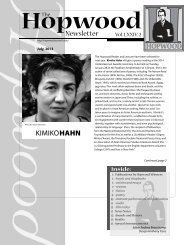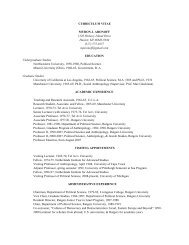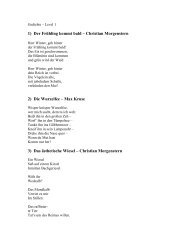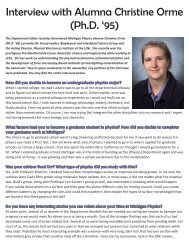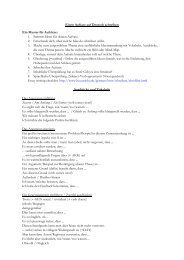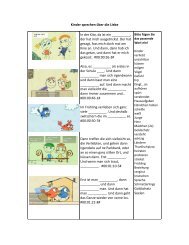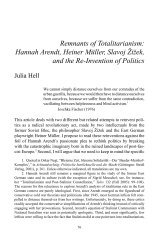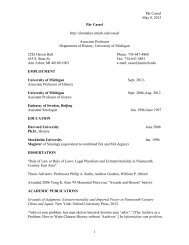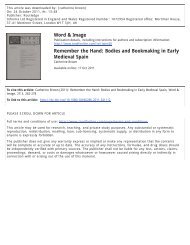Making History Personal: Constantine Cavafy and the Rise of Rome
Making History Personal: Constantine Cavafy and the Rise of Rome
Making History Personal: Constantine Cavafy and the Rise of Rome
Create successful ePaper yourself
Turn your PDF publications into a flip-book with our unique Google optimized e-Paper software.
Frier, “<strong>Making</strong> <strong>History</strong> <strong>Personal</strong>,” page 17<br />
<strong>the</strong> formation <strong>of</strong> his “generic hero,” as Keeley described him. For what comes after defeat, <strong>and</strong><br />
after <strong>the</strong> acceptance <strong>of</strong> defeat, is <strong>the</strong> reemergence <strong>of</strong> a new, more opportunistic citizen, able to<br />
absorb <strong>the</strong> bitterest blows with a certain detachment, or even an amused eye for revelations about<br />
<strong>the</strong> inadequacies <strong>of</strong> his new masters, <strong>and</strong> above all a growing confidence in culture as a more<br />
than adequate replacement for political self-determination.<br />
Totally typical <strong>of</strong> this new attitude is <strong>the</strong> “Sculptor from Tyana” (1893/1903): a Cappa-<br />
docian artist, probably working at <strong>Rome</strong>, who cheerfully accepts all manner <strong>of</strong> commissions<br />
from Roman senators: statues <strong>of</strong> Greek gods <strong>and</strong> heroes, or distinguished Roman generals, or<br />
even <strong>of</strong> <strong>the</strong> doomed Caesarion, Julius Caesar’s putative son by Cleopatra <strong>and</strong> <strong>the</strong> last <strong>of</strong> <strong>the</strong> Pto-<br />
lemies. 53<br />
This is <strong>the</strong> earliest <strong>of</strong> <strong>the</strong> three poems in which <strong>Cavafy</strong> not only mentions Caesarion,<br />
but gives him unanticipated emphasis; <strong>the</strong> o<strong>the</strong>r two are “Alex<strong>and</strong>rian Kings” (1912) <strong>and</strong> “Cae-<br />
sarion” (1914), both considered at length below. It is clear that <strong>Cavafy</strong>’s interest in <strong>the</strong> unfortu-<br />
nate Caesarion was <strong>of</strong> far greater duration <strong>and</strong> depth than <strong>the</strong> introduction to “Caesarion” im-<br />
plies. <strong>Cavafy</strong> even intuits, in “Sculptor,” <strong>the</strong> existence <strong>of</strong> an ancient cult <strong>of</strong> Caesarion—a possi-<br />
bility that, as we shall see, has recently come to seem not entirely unimaginable.<br />
But poems like “Sculptor from Tyana” suggest a still deeper explanation <strong>of</strong> <strong>Cavafy</strong>’s in-<br />
terest in <strong>the</strong> later Hellenistic period. It is hard to imagine a poetic persona that remains, on <strong>the</strong><br />
surface, less cognizant <strong>of</strong> contemporary events than <strong>Cavafy</strong>’s. He seems rarely even to notice<br />
<strong>the</strong> larger course <strong>of</strong> history sweeping forward around him. <strong>Cavafy</strong>’s principal output stems from<br />
1910 onward <strong>and</strong> overlaps with events <strong>of</strong> gargantuan significance for him <strong>and</strong> o<strong>the</strong>r diaspora<br />
Greeks: not least, <strong>the</strong> First World War <strong>and</strong> its aftermath, including <strong>the</strong> mass expulsion <strong>of</strong> <strong>the</strong><br />
Greek population from Turkey. And closer to home, within cosmopolitan Egypt, <strong>Cavafy</strong>’s de-<br />
velopment as a mature poet was bracketed by two major nationalist uprisings against foreign<br />
domination: Col. Ahmed Urabi’s revolt in 1879-1882, put down by a calamitous British naval<br />
bombardment <strong>of</strong> Alex<strong>and</strong>ria (<strong>Cavafy</strong>’s family had packed him <strong>of</strong>f to Constantinople for <strong>the</strong> dura-<br />
tion), <strong>and</strong> <strong>the</strong> 1919 Revolution against British occupation led by Saad Zaghloul <strong>and</strong> <strong>the</strong> Wafd<br />
53 <strong>Cavafy</strong> obviously has his sculptor come from Tyana because <strong>of</strong> <strong>the</strong> Cappadocian city’s connection to Apollonius<br />
<strong>of</strong> Tyana, one <strong>of</strong> his heroes: see Mendelsohn, Collected Poems (2009) 388-389, <strong>and</strong> Bowersock, “Apollonios”<br />
(1983/2009). Mendelsohn (389-390) argues that Caesarion “st<strong>and</strong>s out [from <strong>the</strong> o<strong>the</strong>r commissioned statues]<br />
as something <strong>of</strong> an anomaly among this gallery <strong>of</strong> great Romans,” but “represents, in his parentage <strong>and</strong> his very person,<br />
<strong>the</strong> failed dream <strong>of</strong> a truly Greco-Roman political <strong>and</strong> dynastic unity.” Still, it is unlikely that <strong>Cavafy</strong> himself<br />
had any faith in <strong>the</strong> latter; see below on “Alex<strong>and</strong>rian Kings.” On Caesarion’s parentage, see also below.



